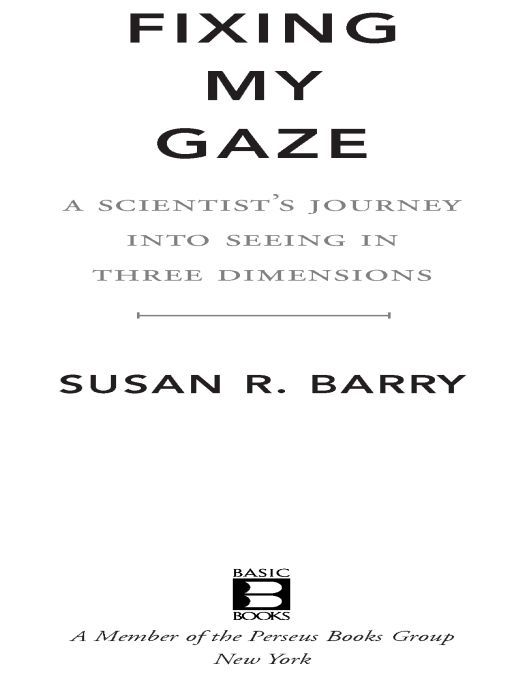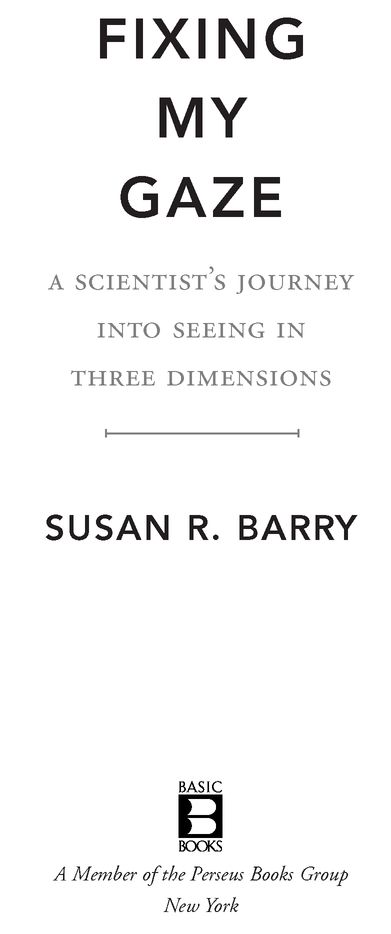Table of Contents
In memory of my mother,
Estelle Florence Fisher Feinstein,
a woman who saw
in great depth.
Note to the Reader
All of the stories in this book are true, but the names of some of the people have been changed to respect their privacy.
Foreword by Oliver Sacks
I first met Sue Barry in 1996 at a launch party for her husband, Dan, an astronaut. We soon got to talking about different ways of experiencing the worldhow Dan, for example, in the microgravity of spaceflight, had no direct sense of up or down, so he had to find other ways of orienting himself in space. She herself, Sue said, experienced the world in an unusual way as a consequence of having developed crossed eyes, or strabismus, in early infancy. Her eyes had been straightened by surgery, and she had 20/20 vision in both eyes, but they were still not fully aligned. Her brain had learned to suppress the image from one eye or the other so that she did not experience a confusing double vision. Normally the brain constructs a perception of depth by comparing the images from the two eyes, but in Sues case, where one or the other image was suppressed, no such comparison was possible. So, though she had learned to judge distance and depth by other cues, she had never experienced true solid vision, or stereoscopy. Her world was entirely flat.
But all in all, she said, she got along perfectly wellshe drove a car, she could play softball, she could do whatever anyone else could. She might not be able to see depth directly, as other people could, but she could judge it as well as anybody, using other cues, such as perspective, occlusion, shading, or motion parallax. It was no big deal.
I asked Sue if she could imagine what the world would look like if viewed stereoscopically, and she said, yes, she thought she couldafter all, she was a professor of neurobiology, and she had read plenty of papers on visual processing, binocular vision, and stereopsis. She felt this knowledge had given her some special insight into what she was missingshe knew what stereopsis must be like, even if she had never experienced it.
But in December 2004, almost nine years after our initial conversation, she wrote me a letter, which began, You asked me if I could imagine what the world would look like when viewed with two eyes. I told you that I thought I could.... But I was wrong.
She could say this with some conviction because she had suddenly, unexpectedly, acquired stereovision herself, and the reality of this, the actual experience, was utterly beyond anything imagination could have conceived. She was almost fifty and had been having increasing visual difficulties resulting from the misalignment of her eyes. Finally, she had embarked on an intensive course of training with a developmental optometrist, and one day, after learning to align her eyes, she suddenly saw the steering wheel of her car popping out from the dashboard. After having lived in a flat world for fifty years, Sue felt this sudden leap into three-dimensionality as a revelation. Her world was now full of a new sort of visual beauty and wonder so deep that three years later, when she wrote to me, she was still enraptured with it.
My new vision continues to surprise and delight me, she wrote.
One winter day, I was racing from the classroom to the deli for a quick lunch. After taking only a few steps from the classroom building, I stopped short. The snow was falling lazily around me in large, wet flakes. I could see the space between each flake, and all the flakes together produced a beautiful three-dimensional dance. In the past, the snow would have appeared to fall in a flat sheet in one plane slightly in front of me. I would have felt like I was looking in on the snowfall. But now, I felt myself within the snowfall, among the snowflakes. Lunch forgotten, I watched the snow fall for several minutes, and, as I watched, I was overcome with a deep sense of joy. A snowfall can be quite beautifulespecially when you see it for the first time.
Most of the phone calls and letters I receive are about mishaps, problems, losses of various sorts. Sues letter, though, was a story not of loss and lamentation but of the sudden gaining of a new sense and sensibility and, with this, a sense of delight and jubilation. Yet, her letter also sounded a note of bewilderment and reservation: she did not know of any experience or story like her own and was perplexed to find, in all she had read, that the achievement of stereoscopy in adult life was impossible.
Indeed, what Sue described to me in her letter went completely against the current dogma of critical periods in sensory developmentthe notion that stereoscopy (like many other aspects of visual perception, and like language, as well)had to be acquired in the first three or four years of life, or it could never be acquired, for the critical brain cells and circuitry needed for stereovision would fail to develop.
Long suspected by surgeons operating on children with strabismus, this notion of a critical period seemed to be confirmed by the famous experimental work of David Hubel and Torsten Wiesel, who showed that if kittens were rendered strabismic by detaching an eye muscle, binocular depth cells would fail to develop in their brains, and they would lack stereovision. It was only when Sue learned of these experimentsshe was a college student at the timethat she realized she herself might be stereoblind, like the kittens. This, indeed, is the vivid opening scene in her narrative:
Stereoblind? Was I stereoblind? I looked around. The classroom didnt seem entirely flat to me. I knew that the student sitting in front of me was located between me and the blackboard because the student blocked my view of the blackboard. When I looked outside the classroom window, I knew which trees were located further away because they looked smaller than the closer ones. The footpath outside the window appeared to narrow as it extended out into the distance. Through cues like these, I could judge depth and distance. I knew the world was in 3D. Yet, my professor implied that there was another, different way to see space and depth. He called this way of seeing stereopsis. I couldnt imagine what he was talking about.
When Sue next went to her eye doctor for a routine check, she asked him to check whether she had stereovision. He brought out a stereoscope and test stereo pictures. Sue could not get any of them, could not imagine what getting them would be like. Would it be possible for her to gain stereovision, she asked? The doctor replied, no, it was much too late, and added, Stereopsis is just a little fine-tuning for the visual system. You dont need stereovision because you dont have stereovision.
Sue accepted that she would never have stereovision and got on with her life, becoming a teacher and researcher, marrying, and raising a family. Somewhere, at the back of her mindfor she is a scientist and incessantly curious about how the world workswas a question: what could stereovision be like? And yet, her life, visually and otherwise, was full and rich, and she did not miss stereo or think of it too much. So thirty years later, when she finally sought vision therapy and unexpectedly gained stereovision, this came as a bonus, a miraculous complement to her other visual improvements.
Sue exulted in her newfound sense of stereoscopic depth. She found it much more than fine-tuningit was an entirely new way of seeing. People who have always had stereopsis, she said to me, take it for granted. They have no idea how wonderful it is. You have to have been stereoblind for half a century and then acquire it to value it properly.







